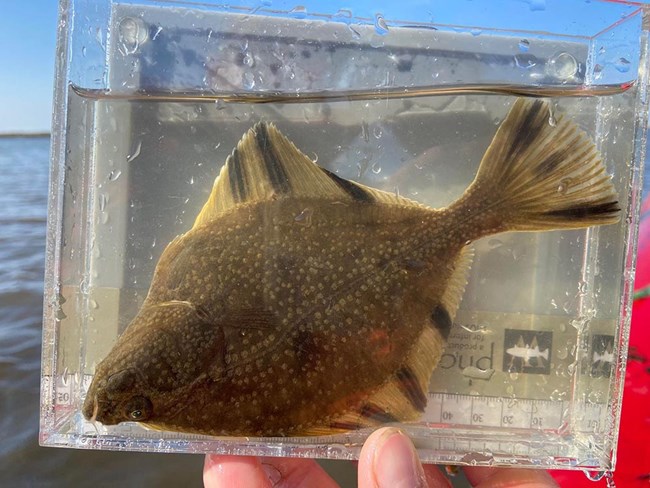Last updated: August 5, 2022
Article
Factors that Affect Habitat and Trophic Ecology of Fishes in Cape Krusenstern National Monument Coastal Lagoons

Wildlife Conservation Society
Lagoon ecosystems, which comprise approximately 40% of Alaska’s Arctic coastline and are common along the coast of Cape Krusenstern National Monument, feature a unique set of physical and ecological characteristics that set them apart from other marine and freshwater habitats. Lagoons are highly dynamic, seasonally productive systems that undergo a range of physical changes. In the summer months, when they typically connect to the ocean, they host large numbers of subsistence-harvested fishes such as whitefish (Coregoninae), flounder, (Pleuronectidae), and cods (Gadidae) that are important for the food security of Indigenous and rural residents of the region. However, in the winter months, they are cut off from the marine environment by ice and gravel berms, can freeze solid, and may represent a deadly trap for fishes that remain within. Lagoon fisheries monitoring efforts conducted by the Wildlife Conservation Society, National Park Service, and Native Village of Kotzebue Environmental Program starting in 2012 have revealed that lagoon connectivity to the ocean influences the species of fish present in lagoons, and their abundance. However, the drivers that affect lagoon connectivity to the ocean, and the deeper ecological effects of the changing lagoon environment on food webs and fish trophic ecology have not previously been examined.
Stable isotope chemistry has been employed for decades for studying food webs in terrestrial and aquatic environments. To describe environmental effects on fish trophic dynamics in lagoons of Cape Krusenstern National Monument, Carbon and Nitrogen isotope ratios from muscle tissue of several marine and diadromous fish species were examined in lagoons with differing physical characteristics. Namely, the amount of freshwater input into a lagoon (length of connected stream network), lagoon area, distance from the ocean via channel, and duration of connectivity to the ocean were characterized for three lagoons within Cape Krusenstern National Monument, and fish stable isotope values for three species of subsistence importance were compared to these physical factors to illuminate patterns. Fish species examined included Pacific herring (Clupea pallasii), humpback whitefish (Coregonus pidschian), and starry flounder (Platichthys stellatus), representing an array of life history strategies.
Results from analyses indicated that increased freshwater input was associated with increased duration of lagoon ocean connectivity. Examining the isotopic ratios in the three species of interest, variable trophic responses to lagoon connectivity to the ocean and distance from the sea were evident. Increased ocean connectivity resulted in higher Nitrogen and Carbon isotope ratios across species, likely because fishes have additional opportunities to move back and forth between the lagoon and marine environment where enriched marine-derived nutrients can be acquired. In Krusenstern Lagoon, for the two marine fishes which were required to swim further distances from the ocean to reach it, isotopic ratios were lower, undoubtedly due to reliance on freshwater prey items (unenriched with marine nutrients) and low likelihood of moving multiple kilometers back to the ocean to feed while occupying the lagoon.
With the benefit of multiple years of ecological data collected from Arctic coastal lagoons, it is clear that these habitats are highly dynamic ecosystems, and the movements, abundance, and feeding patterns of fish inhabiting them are affected through abiotic factors that may be altered in the future due to climate change and human development. With increased coastal erosion and construction of coastal infrastructure in the Arctic (e.g., causeways and ports), physical factors like lagoon connectivity to the sea and amount of freshwater input could be changed, subsequently affecting the fish populations that Indigenous and rural subsistence harvesters rely on for food security. Therefore, it is important to assess and ponder the effects that future coastal development projects may have on lagoon ecosystems.
Freshwater input and ocean connectivity affect habitats and trophic ecology of fishes in Arctic coastal lagoons
Abstract
Arctic coastal lagoons are important habitats for unique assemblages of diadromous and marine fishes. Many of these fishes are vital to the food security of rural and indigenous communities. However, human impacts on coastal Arctic habitats, as well as climate change, weaken ecosystem resiliency and threaten the sustainability of fish stocks as a component of local food security. Identifying how habitat characteristics influence fish ecology may allow for predictions of changes in fish abundance and availability in response to these threats, and may help illuminate strategies for responding to negative impacts. Consequently, we endeavored to link habitat characteristics likely to be most-impacted by climate change to fish assemblage trophic metrics in four lagoons within Cape Krusenstern National Monument, Alaska where subsistence fishing commonly occurs. This was done through calculating trophic metrics including mean nitrogen (δ15N) and carbon (δ13C) stable isotope values from fish muscle tissue samples collected from the study lagoons. Lagoon habitat characteristics were quantified including ocean connectivity, freshwater input, and surface area using satellite imagery. Finally, associations between fish assemblage trophic metrics and habitat characteristics were evaluated using linear regressions, and trophic metrics were compared between lagoons with ANOVA and Tukey post-hoc tests. Model results showed that increased freshwater input resulted in longer duration of lagoon ocean connectivity. Additionally, longer duration of ocean connectivity was associated with an increase in mean δ15N and δ13C across all lagoon fish species. Finally, there were significant species-specific differences in fish trophic metrics among lagoons with varying habitat characteristics. Overall, freshwater input and ocean connectivity of coastal Arctic lagoons appear to be important drivers of fish trophic ecology, and should be carefully monitored in the face of anticipated changes in the region, to conserve important subsistence harvest species.
Fraley, K. M., M. D. Robards, M. C. Rogers, J. Vollenweider, B. Smith, A. Whiting, T. Jones. 2021. Freshwater input and ocean connectivity affect habitats and trophic ecology of fishes in Arctic coastal lagoons. Polar Biology: 44, p1401–1414.
